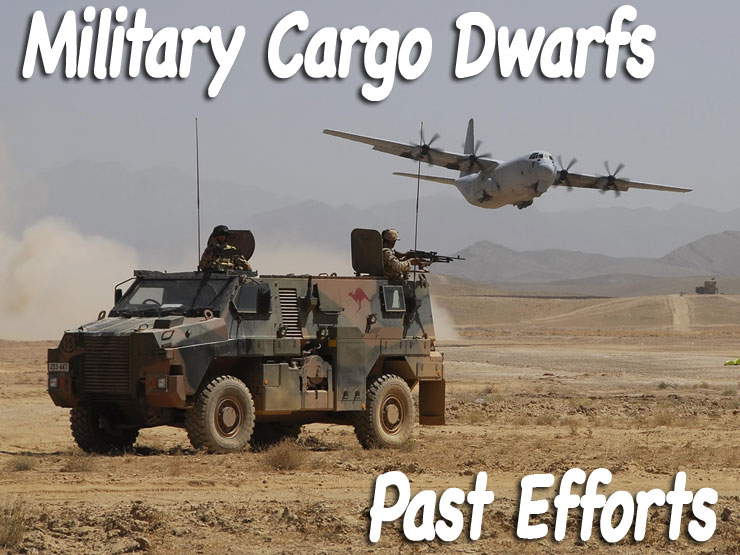
Every year we celebrate Memorial Day in
the USA, the official start of Summer and this year it was also the 66th
year marking June 6,1944—D-Day in France.
While these occasions are noted and exploited
with almost non-stop military programs on certain TV channels, as the
new century progresses some perspective might be useful.
Today, modern air cargo of the USA Air Mobility
Command routinely moves all manner of goods and troops to various theaters
of war with the kind of regularity usually associated with civilian overnight
services, and in volumes that actually dwarf some of the more famous mass
freight movements in history, including the China India Burma Hump fliers
of World War II and The Berlin Airlift of 1948.
It is true that those early movements electrified
the world by their vision and execution and were pioneer efforts that
inspired the birth of a great industry.
But right now in Southern Afghanistan, for
example, they are building the foundations to both create and support
a major buildup of USA troops that in large part will be initiated and
supported down the line from the air.
Any number of USA flags who are part of
the CRAF program are utilized to move troops and critical supplies to
and from the USA to forward bases in both Iraq and Afghanistan.
That task was made quite a bit easier earlier
last year when the USA and Russia agreed on a plan that allows USA military
troop and supply aircraft to overfly Russian Federation airspace.
The agreement saves about $140 million in
fuel costs annually and insures safer passage in and out of the theaters
without having to move overland through Pakistan, where attacks have been
attempted and truck convoys are easy targets.
Dubai also plays a large figure in the movement
of hard cargo and other supplies into Iraq and Afghanistan via any number
of independent operators, such as Rus Cargo and others, including several
small to medium ad-hoc carriers.
 Air
cargo into these war zones at times resemble operations that could have
been lifted straight from the pages of Terry & The Pirates, a 1930s
comic strip that glamorized air cargo flights to far away places like
China and India. Air
cargo into these war zones at times resemble operations that could have
been lifted straight from the pages of Terry & The Pirates, a 1930s
comic strip that glamorized air cargo flights to far away places like
China and India.
Right now with Dubai as a conduit, all cargo
travels daily and around the clock into war zones, and at times aboard
vintage equipment.
Over Afghanistan on any given day are scores
of C-130s, their cargo bays holding about six tons of cargo strung with
parachutes.
Although the venerable Lockheeds have served
in one theater of war or another in updated versions since Vietnam, they
are still on the job in 2010, air dropping supplies for U.S. troops at
remote sites, bringing frozen food, fruit drinks, ammunition and spare
parts to the front lines.
The ability to airdrop supplies and land
C-130s with cargo on remote dirt airstrips is vital to keeping the war
effort in Afghanistan supplied and in business.
Dispersing the troops safely is a key element
of the strategy that will add 30,000 more of their numbers to provide
security for Afghanistan's population, which is scattered in thousands
of rural villages, dusty crossroads and deep mountain valleys.
There, the roads are also too dangerous
to convoy supply trucks, as attested by loss figures gathered by the US
Pentagon.
Bandits and hostiles make over the road more like over the rainbow.
In best case scenarios, even in good weather
it takes an average of three weeks for a truck to move from Bagram Air
Field, where cargo flights arrive from the U.S. and Europe, to Kandahar,
the staging base for allied forces in southern Afghanistan.
In winter, a road convoy can take twice
as long.
Today, the skies above Afghanistan are alive
with C-130s, jet fighters, unmanned drones, commercial 747 cargo aircraft,
transport and attack helicopters and even occasional artillery shells.
Air Cargo moves in a never ending ballet
amongst all traces of combat and commerce, bringing hope and deliverance
to ever growing legions of kids from Columbus, Ohio; Butte, Montana; and
Newark, New Jersey, who find themselves at a remote location somewhere
in Afghanistan as that conflict drags on.
In the USA, Defense Logistics Agency (DLA)
supply centers and support team logisticians have spent the past several
months working with U.S. Central Command and U.S. Forces Afghanistan officials
to support additional forces in the country.
For example, DLA’s supply chains have
been involved in the planning effort, including Defense Supply Center
Philadelphia, which provides food, construction material, medical items,
clothing and individual equipment.
A key element of the Afghanistan support
strategy is the development of the Northern Distribution Network.
This initiative provides additional routes
to move material to troops on the ground through the South Caucasus and
Central and South-Asian states.
Still, geography, the lack of extensive
complementary transportation links and minimal security on them will continue
to be a major challenge looking ahead at the US military effort in Afghanistan.
No doubt the book is being rewritten in
large part as there are major differences operating logistics chains into
Iraq and Afghanistan.
Looking at both places by comparison reveals:
Supply chains into Iraq are operated from
'safe havens' for the US in Jordan (where Aqaba has been used) and Turkey
for activities in the North.
In Afghanistan, there is nothing comparable
- certainly not on the all-important frontier between Afghanistan and
Pakistan.
Also, in Baghdad the U.S. military has been
able to utilize remnants of an international airport with substantial
existing commercial infrastructure.
The legacy Iraqi Airways cargo facility
was dated, but better than many seen in developing countries, and you
do have some commercial airline activity running in there.
It is widely felt that there have been some
important misjudgments about rehabilitating the Iraq gateway, including
granting operating concessions there, but at this point at least it looks
doubtful that comparable interests are in place at Kabul.
Moreover, the surface transportation of
Afghanistan is not remotely comparable—in condition, extent or security—to
what exists around Baghdad and Fallujah.
It may seem cliché, but basic common
sense holds that superiority in moving troops and supplies has had an
undeniable relationship with outcome in wartime.
It is no small coincidence that the creators
of the Roman Roads—guys who recognized that major arteries for troops
and supplies should have a peak for drainage, rather than be flat—helped
develop a mighty extensive empire.
Geoffrey
|





